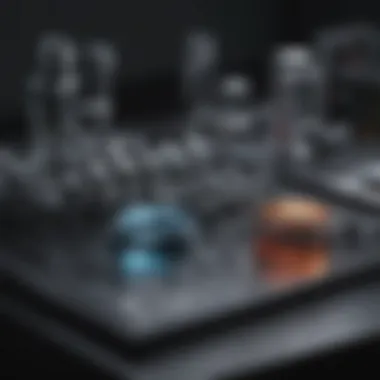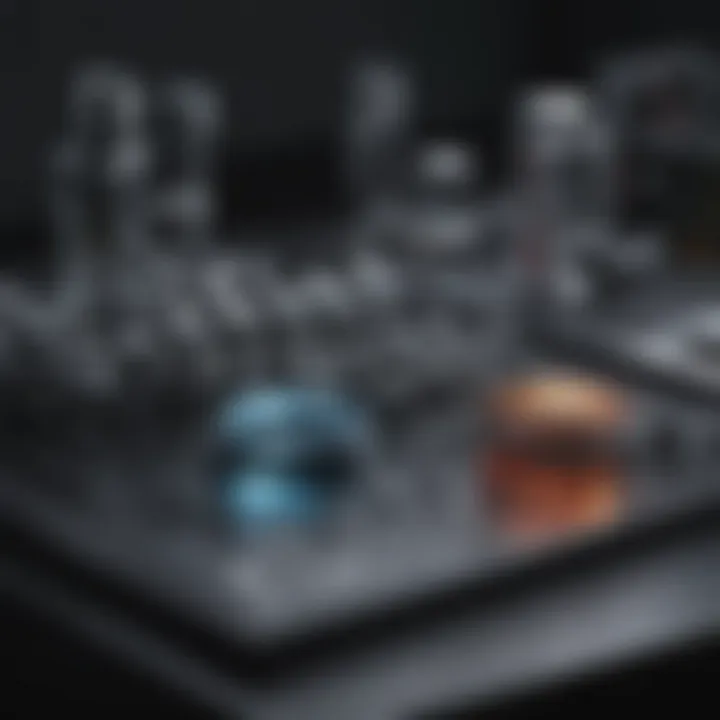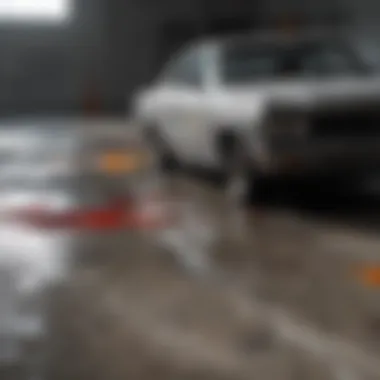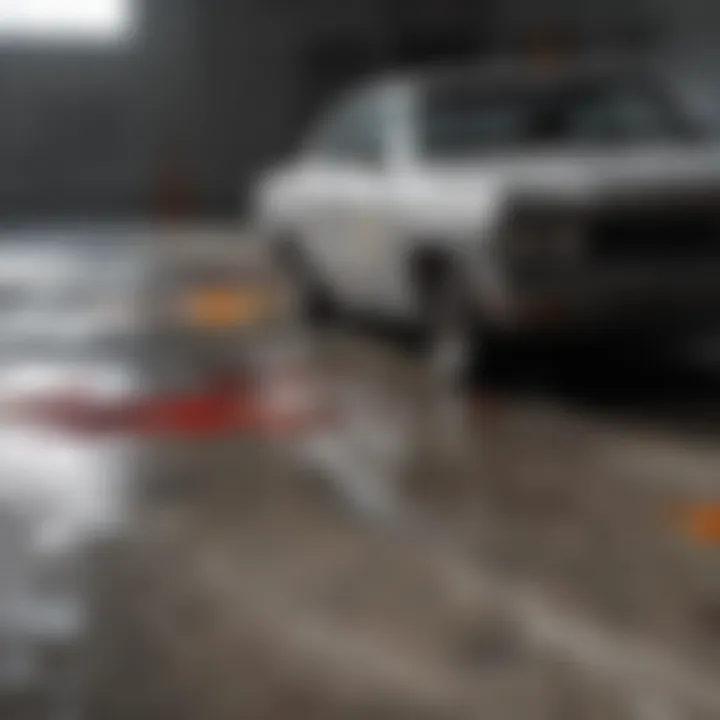Forensic Paint Analysis: Methods and Importance


Intro
Forensic paint analysis is the unsung hero in the world of crime scene investigations. While the spotlight often shines on fingerprints and DNA, the humble paint chip can hold just as much weight in linking a suspect to a crime. Painted surfaces are everywhere, from vehicles to buildings, and the analysis of these materials can unveil critical evidence. This article aims to delve into the systematic nature of paint analysis, shedding light on the methodologies used and the significance of this field in current investigations.
Research Overview
Methodological Approaches
The approach to forensic paint analysis typically involves meticulous collection and examination methods. It starts with sampling, where suspected paint is carefully collected from a crime scene or a suspect's belongings.
- Visual Inspection: Initially, a basic visual inspection is performed. This involves examining the layer composition, color, and texture.
- Microscopic Analysis: Next comes microscopic examination. Forensic experts use a polarizing light microscope to analyze the paint layers, revealing not just the color but also the thickness of each layer, which can provide clues about its origin.
- Chemical Analysis: Chemical composition is assessed using techniques like Fourier-Transform Infrared Spectroscopy (FTIR) and Gas Chromatography-Mass Spectrometry (GC-MS). These methods determine the specific compounds in the paint, offering insight into where it might have come from.
- Comparison: Finally, the data collected from samples is compared to reference samples. This step is crucial in making connections between the paint found at the scene and the suspect.
Significance and Implications
The importance of forensic paint analysis cannot be overstated. It provides tangible links between physical evidence and suspects, often supporting other forensic findings. When a paint sample matches one taken from a vehicle, for example, it can place the suspect at a crime scene.
Moreover, as technology progresses, the implications for future investigations are significant. More refined techniques can only enhance the precision and reliability of paint analysis in legal contexts, ultimately contributing to a more robust justice system. It reinforces the idea that every detail can matter, turning a seemingly insignificant piece of evidence into the cornerstone of an inquiry.
Current Trends in Science
Innovative Techniques and Tools
Recent advancements have brought forth innovative techniques in forensic paint analysis. The advent of digital imaging systems allows for enhanced visualization of paint layers, minimizing the risk of sample destruction during analysis. Technologies such as X-ray fluorescence (XRF) provide non-destructive testing methods, which can analyze surface compositions without damaging them.
Interdisciplinary Connections
Forensic paint analysis doesn't operate in isolation. It intersects with various fields, including chemistry, materials science, and even digital forensics. By fusing expertise from these different domains, forensic experts can develop more robust methodologies that yield richer, more reliable data. This interdisciplinary approach ensures that forensic paint analysis continues to evolve, meeting the needs of today's complex investigative landscapes.
"Forensic science is not merely about solving crimes; it's about understanding the intricate layers of evidence that can tell a story."
In summary, forensic paint analysis serves as a pivotal component in criminal investigations, weaving together scientific techniques and analytical practices that deepen our understanding of evidence. As we continue to investigate, adapt, and innovate, the future of this field holds great promise for enhancing justice processes.
Prolusion to Forensic Paint Analysis
Forensic paint analysis is not just a niche discipline within criminology; it represents a crucial intersection of science and law. Understanding paint composition can unlock significant details in a criminal investigation, providing tangible connections between evidence found at a scene and individuals involved in the crime.
Paint, while commonly seen as an ordinary material used for decoration or protection, is composed of complex layers and various chemical compounds. Each type of paint, whether it be from an automotive finish or architectural coating, has unique attributes. This specificity means that paint can serve as a valuable tool in solving crimes, particularly when distinguishing between places, times, and materials.
Furthermore, forensic paint analysis can significantly aid law enforcement in a myriad of ways:
- Identification of materials: By analyzing the paint samples, experts can often determine the origin of the material. Knowledge of vehicle paint, for instance, can lead investigators to the exact make and model involved in a hit-and-run.
- Linking suspects to crime scenes: When a suspect has traces of paint on their clothing or vehicle, forensic analysts can compare it to samples collected from a crime scene. This connection is vital for establishing presence or involvement in a crime, making it a powerful piece of evidence in court.
- Elimination of false leads: Not every fragment of paint is relevant. Forensic paint analysts can quickly dismiss irrelevant paint types, allowing investigators to focus on leads that truly matter.
To delve deeper, one must appreciate the multifaceted process involved in forensic paint analysis. From collecting evidence at a crime scene to employing sophisticated scientific techniques for analysis, each step requires meticulous attention to detail. This discipline entails methodical procedures that ensure the integrity and reliability of results.
In short, forensic paint analysis is more than just identifying pretty colors. It’s a rigorous examination that requires a keen understanding of chemistry, careful consideration of physical evidence, and a passionate commitment to the quest for justice. As the legal landscape continues to evolve and integrate advanced methodologies, the relevance of forensic paint analysis will only grow, offering profound impacts not just for individual cases, but for the field of forensics as a whole.
"The devil is in the details." In the sphere of forensic paint analysis, every fleck of paint could be the key that unlocks the mystery of a crime.
Importance of Paint Analysis in Forensics
Forensic paint analysis is more than just a tool; it is a bridge between the present and the past, linking the pieces of a puzzle to uncover the truth in criminal investigations. It serves numerous critical functions that underscore its importance in the broader context of forensics.
One significant aspect is its ability to provide intimate insights into a crime scene. Paint can serve as a silent witness, allowing forensic experts to understand the dynamics of how a crime unfolded. For instance, when a suspect leaves behind a specific hue of paint, it can be traced back through various techniques to not only establish the presence of the individual but also to understand the vehicle, tools, or environment associated with that particular shade. This connection can be instrumental in piecing together narratives relevant to the investigation.
Moreover, analyzing paint samples can help establish timelines. The paint's age or the way it has deteriorated can indicate whether or not it matches a suspect's timeline or whereabouts. This time critical analysis often becomes a pivotal factor in demonstrating the suspect's involvement.
"In the intricate workings of the justice system, every layer of evidence counts. Paint analysis often reveals more than just color; it tells a story."
Role in Crime Scene Investigation
The role of paint analysis in crime scene investigation cannot be overstated. It acts like a fine thread that holds together different elements of an investigation.


In various instances, paint chips collected from a suspect’s clothing or vehicle can be rigorously compared to markings found at the scene of the crime. Such analyses have historically contributed to high-profile cases, including burglaries and traffic accidents. The colors, finishes, and layers of paint, when examined meticulously, can pinpoint very specific sources—like a particular manufacturer or product line—thereby creating links.
Additionally, the methods employed in paint analysis can extend beyond visual assessments. Forensic scientists utilize advanced methodologies, such as microscopy and spectroscopy, to dissect the paint’s composition, chemical properties, and physical characteristics. These detailed examinations can reveal telling nuances about where the paint originated, which in turn can substantiate claims about the circumstances surrounding the crime scene.
Connecting Evidence to Suspects
Connecting evidence to suspects is where forensic paint analysis can truly shine. The color and type of paint found at a crime scene can often correlate with specific vehicles or buildings, essentially mapping a forensic fingerprint back to a suspect.
In an ideal scenario, investigators will locate paint debris from a suspect’s vehicle that matches samples from the crime scene. This can enhance a prosecutor's case when it comes to connecting a defendant with the act in a legal setting. The methodical approach to gathering and analyzing paint samples acts like a documented history, substantiating who might have been at the scene and when.
In contemporary forensic investigations, digital databases have emerged, allowing easier access for cross-referencing paint samples against known standards. This advancement provides an even more efficient way for leveraging paint as a vital form of evidence, illustrating how the landscape of forensic science is evolving.
Despite its complexities, the analysis of paint remains a cornerstone of jurisprudence, often transforming scenes of mere conjecture into narratives grounded in fact.
Understanding Paint Composition
Understanding the composition of paint is fundamental when it comes to forensic analysis. Each paint type, ranging from those used in household items to automotive finishes, contains unique properties and components that can be critical in linking paint evidence to a crime scene. Analyzing these elements not only aids in establishing the origin of the paint but also plays a vital role in corroborating the evidence collected during an investigation.
Types of Paints Used in Forensics
In the realm of forensics, various types of paints are analyzed, and each serves a particular purpose. These include:
- Acrylic Paints: Often found in artistic applications, these are water-based and dry quickly. The composition includes pigments and polymers, making them crucial in cases involving graffiti or art-related crimes.
- Alkyd Paints: Common in household applications, alkyd paints often contain linseed oil mixed with pigments. They are known for durability and are often found on exterior surfaces, providing important clues in residential burglary cases.
- Automotive Paints: The highly specialized formulations in car paints can reveal the make and model of a vehicle involved in a crime. This paint type includes a primer, base coat, and clear coat, each contributing distinct chemical signatures.
- Powder Coatings: While less common, these baked-on coatings, often used for appliances and automotive parts, can sometimes be found at crime scenes and might be significant in accident investigations.
Chemical Properties of Paints
Paints are complex mixtures, and their chemical properties play a pivotal role in analysis. Here are some key considerations:
- Pigments and Dyes: The color of a paint is attributed to its pigments or dyes, which can vary greatly from one manufacturer to another. This variance allows forensic analysts to determine the paint source and match it to objects at a crime scene.
- Binders: These are the resins that hold the pigment particles together. The type of binder affects the paint's properties, such as durability and drying time, which can be informative for investigators trying to establish timelines.
- Additives: Various substances are added to paints to enhance characteristics—these can include drying agents, UV stabilizers, and anti-settling agents. Understanding these additives helps forensic teams dig deeper into paint samples, leading to crucial insights regarding the specific brand or manufacturer.
- Solvent Composition: The solvents used in paint formulations affect how the paint behaves. Forensic scientists study the solvent ratios, as they may reveal whether a paint sample is associated with specific environmental conditions or chemical uses.
"In every drop of paint, there’s a world of information waiting to be uncovered, with each element playing its part in the story of a crime."
The analysis of paint composition does not merely facilitate the identification of materials; it enriches the forensic narrative by helping to place individuals at particular scenes or events, which is the crux of criminal justice.
Methodologies in Forensic Paint Analysis
Understanding the methodologies behind forensic paint analysis is crucial to grasp how professionals piece together the puzzle in criminal investigations. Each technique has its own strengths and weaknesses, shaping how evidence is interpreted and utilized in court. A comprehensive investigation into paint can determine origins, connections, and even the manner of a crime.
Visual Inspection Techniques
Visual inspection is the first step in forensic paint analysis. Though it might seem straightforward, it is an art as much as it is a science. Trained analysts examine the paint for various attributes: color, texture, and layering can all tell a tale. For instance, a chipped piece of paint may have layers that indicate whether it came from an older vehicle or a freshly painted surface. Analysts often use tools like magnifying glasses to discern finer details that might escape the naked eye.
The examination of color alone can help identify the manufacturer, model, or year of a vehicle, thus creating a crucial link to a suspect.
In addition, visual techniques might include photographing samples under different lighting. Sometimes, a paint's reaction to ultraviolet light can reveal additional layers and more nuanced colors that aren’t visible otherwise.
Microscopy in Paint Analysis
Microscopy opens up a new level of depth in paint analysis. Using light microscopy, forensic scientists examine paint samples at high magnifications. This method reveals the paint’s structure, including pigment particles and binders. Scanning electron microscopy (SEM) can go even further, offering highly detailed images that allow for elemental analysis. Each component provides clues that help piece together the paint’s history and source.
For example, the specific size and shape of pigment particles can be unique to certain manufacturers. A forensic scientist may determine that a piece of paint from a crime scene belongs to a specific car make just by analyzing the microscopic composition of the paint.
Chromatography Applications
Chromatography is essentially the financial consultant of paint analysis, laying out the separation of components in a sample, one after the other. By applying techniques such as thin-layer chromatography or gas chromatography, analysts can break down the chemical composition of paint. Different brands utilize distinct combinations of solvents and pigments, enabling a level of specificity that’s unmatched.
In practical terms, what does this mean? If a paint sample suspected in a crime scene can be separated and compared to a known database of paint formulations, it can solidify a connection or point away from a suspect. This method is particularly crucial in cases where visual or microscopic evidence alone might prove inconclusive.
Infrared Spectroscopy Utilization
Infrared spectroscopy utilizes light absorption to reveal the chemical makeup of paint samples. The way a sample absorbs infrared light helps identify functional groups within the paint components. This technique is particularly powerful because it can provide definitive evidence of the specific solvents and binders used in a paint formulation.


Infrared spectra can distinguish between organic and inorganic compounds, helping analysts understand the paint’s formulation intimately. When results are compared against a library of known paint formulations, connections to specific products become all too clear. This adds yet another layer to the investigation, providing insights that can decisively point toward a suspect or validate a timeline.
In essence, all these methodologies—visual inspection, microscopy, chromatography, and infrared spectroscopy—work together to create a robust framework for forensic paint analysis. Each has its strengths and should not be seen as standalone techniques but rather as components of an overarching analytical tapestry that is fundamental in the quest for justice.
Analytical Techniques in Detail
In the realm of forensic paint analysis, analytical techniques are the backbone, providing critical insights into paint samples collected from crime scenes. These methods help forensic experts decipher the unique characteristics of paint, unraveling clues to identify sources or link suspects to specific locations. Understanding these techniques not only enhances the validity of forensic evidence but also elevates the overall integrity of investigations. The effectiveness of these approaches can greatly influence the outcomes in legal contexts, making it an essential area of study for law enforcement and forensic specialists alike.
Scanning Electron Microscopy
Scanning Electron Microscopy (SEM) stands out in paint analysis due to its unparalleled ability to offer high-resolution images of paint samples. This technique allows forensic experts to visualize the intricate topography and composition of a paint layer at a microscopic level. By providing detailed surface observations, SEM can reveal subtle features such as particles embedded within the paint, variations in texture, and layering effects.
One significant advantage of SEM is its capability to analyze samples in their natural state without requiring extensive preparation. By using a focused beam of electrons, it generates surface images and can also provide chemical composition through energy dispersive X-ray spectroscopy (EDX). This synergy between SEM and EDX makes it particularly useful when attempting to differentiate between various paint formulations that might otherwise appear identical to the naked eye.
Using SEM, investigators can trace the origin of a paint sample with remarkable precision. The minute details captured by this method can serve as compelling evidence in criminal cases. Additionally, SEM helps in cross-comparison between samples from different sources, aiding in constructing a profile of possible suspects or relevant locations.
Energy Dispersive X-ray Spectroscopy
Next, Energy Dispersive X-ray Spectroscopy, commonly referred to as EDX, complements analytical capabilities of techniques like SEM. Utilizing an electron beam, EDX detects X-rays emitted from elements in the paint, providing a detailed elemental composition profile. This quantitative analysis is essential for distinguishing between similar paint types that could otherwise lead to ambiguity in findings.
The strength of EDX lies in its effectiveness in identifying inorganic pigments and additives, crucial for matching paint samples found at crime scenes to specific manufacturers or products. For instance, automotive paints, which are frequently involved in hit-and-run cases, can be analyzed to reveal elements like aluminum, titanium, or barium, aiding in narrowing down potential vehicles involved.
Moreover, EDX allows for rapid analysis with minimal sample destruction, preserving evidence for further tests. This technique not only assists in forensic investigations but also is invaluable in historical preservation and art restoration, showcasing the multidisciplinary role of paint analysis.
Raman Spectroscopy Advancements
Raman Spectroscopy has emerged as a game-changer in forensic paint analysis, offering non-destructive chemical characterization of paint samples. By utilizing laser light to probe molecular vibrations, Raman spectroscopy provides a unique fingerprint for different pigments and binders, enabling precise identification without altering the sample.
One key advancement in Raman spectroscopy is its capability to analyze samples in situ, which means that forensic experts can assess paint directly at the crime scene or on objects without worrying about contamination or damage. This real-time analysis can accelerate the investigative process significantly.
Furthermore, the latest developments in portable Raman spectrometers make it possible for field agents to conduct on-the-spot analysis, eliminating the delays involved in sending samples to a lab.
This ability to quickly gather data enhances the decision-making process at crime scenes, with implications stretching across law enforcement and emergency response scenarios. With continued advancements in technology, the resolution and sensitivity of Raman spectroscopy are anticipated to improve, leading to even more accurate forensic paint analyses.
"Technological advancements in analytical techniques are not just improving the efficacy of forensic processes; they are revolutionizing the way we interpret material evidence in criminal investigations."
In summary, the integration of these analytical techniques—Scanning Electron Microscopy, Energy Dispersive X-ray Spectroscopy, and Raman Spectroscopy—forms a comprehensive toolkit for forensic experts. Each method offers distinct advantages and insights, significantly contributing to the thorough examination of paint evidence, whether in criminal investigations or historical analyses.
Challenges in Forensic Paint Analysis
Forensic paint analysis might seem straightforward on the surface, but it's like peeling an onion—each layer reveals complexities that can lead to headaches for investigators. Understanding the challenges in this field is crucial because these factors can significantly affect the outcome of criminal investigations. Issues such as cross-contamination and variability in paint samples can mislead an investigation. Therefore, appreciating these challenges paves the way for improved methodologies and practices, ultimately aiding in the pursuit of justice.
Cross-Contamination Issues
One of the primary concerns in forensic paint analysis is cross-contamination. This situation occurs whenever paint particles from one source unintentionally mix with those from another. It can arise through various means, such as handling evidence without proper care, storing samples in unsuitable environments, or even during the transportation of samples to a lab.
The importance of controlling this phenomenon cannot be overstated. Any mix-up may result in faulty conclusions. For instance, if a paint sample from a suspect’s vehicle is tainted by another paint sample from a different location, it could mislead investigators, causing them to associate a suspect with a crime they didn’t commit.
To combat cross-contamination, forensic experts implement strict protocols, which include:
- Using dedicated tools for each sample.
- Maintaining clean workspaces.
- Employing proper packaging techniques for evidence.
Ensuring these measures are in place can mitigate risks, but it's crucial for forensic professionals to remain vigilant.
Variability in Paint Samples
The second significant challenge in forensic paint analysis stems from the variability in paint samples. Just because two paint swatches appear similar under the naked eye doesn't mean they share the same chemical constituents. Factors like the age of the paint, environmental influences, and the surface to which the paint was applied can cause unexpected changes in the chemical structure.
This variability can lead to misguided interpretations if not comprehensively considered. For instance, someone might assume that a blue paint chip found at a crime scene matches a suspect's car based merely on color. However, without precise analytical methods, this assessment could miss critical differences, such as the inclusion of specific additives or pigments that distinguish the two sources.
Thus, forensic analysts must utilize advanced techniques, like chromatography or mass spectrometry, to verify the composition of paint samples deeply. Some common aspects that can lead to variability include:


- Environmental degradation, which alters the original chemical makeup.
- Variations in manufacturing processes, which result in slight differences in paint types.
- Differences in application methods, leading to unique layer structures.
Addressing these concerns demands a robust methodology and an understanding that forensic paint analysis is, at times, more art than science.
"In forensic science, the devil is often in the details."
Case Studies: Real-World Applications
In the realm of forensic science, case studies illustrate the tangible impacts of methodologies applied to real-world situations. Forensic paint analysis is no exception. The significance of understanding how paint evidence has played a crucial role in investigations can't be overstated. By scrutinizing both high-profile crimes and everyday accidents, forensic paint analysis unveils narratives hidden in mere flecks of color. This section will delve into two distinct areas where forensic paint analysis offered pivotal insights: high-profile criminal cases and accidental incidents.
High-Profile Criminal Cases
High-profile criminal cases capture public attention and often serve as the test bed for forensic innovations. Paint samples recovered from the scene of a crime can dazzle with their complex stories. For instance, in the case of the OJ Simpson trial, paint analysis played a significant role. The infamous white Ford Bronco, later linked to Simpson, had paint chips left on a fence at the crime scene. Experts analyzed these chips and confirmed they matched the vehicle's paint composition, providing a vital connection between the vehicle and the crime committed.
Careful analysis of the paint's layers and chemical composition allowed forensic experts to affirm the origin. Through these analyses, investigators could link physical evidence to suspects in a way that mere eyewitness testimony might not supply. By confirming these connections through scientific means, investigators solidified their cases against suspects, breathing clarity into chaotic narratives.
Similarly, in other notable cases, such as the 2015 London bicycle murder, a paint analysis was instrumental in convicting the perpetrator. The victim's helmet contained paint particles from a vehicle involved in the hit-and-run. Here, paint acted as more than a mere accident marker; it decisively pointed to culpability, correlating with testimony and other physical evidence.
Accidental Incident Investigations
It's not just murder investigations where paint analysis shines. Everyday accidents also benefit from the scrutiny of forensic paint analysis. Consider a scenario involving a car crash. In an accident involving two vehicles, paint samples from the damaged areas can reveal shocking truths. Through careful analysis, layers of paint can indicate the make and model of the offending car, assisting in identifying the driver who fled the scene.
In some instances, paint chips embedded in a victim's clothing following a workplace accident have led investigators to discover unsafe materials were used which weren't in compliance with safety regulations. Here, paint analysis can influence legal actions against companies, ensuring that accountability is upheld.
Bringing in forensic experts who analyze the chemical makeup of paint samples can reveal mismatched compounds or unauthorized materials utilized in products.
"Every layer of paint tells a story. Whether it's from a crime scene or an accident, forensic paint analysis lays bare connections unseen to the naked eye."
Real-world applications of paint analysis continue to contribute to the broader field of forensics. Each case—whether criminal or accidental—fortifies the understanding that paint, while often seen as insignificant, can serve as a telling piece of evidence in the puzzle. Understanding how these case studies function offers critical insights into the effectiveness and importance of a thorough forensic paint analysis.
The Future of Forensic Paint Analysis
As the realm of forensic science continues to evolve, forensic paint analysis stands on the brink of transformative advancements. This evolution is not merely about adopting new techniques; it's about enhancing the very foundations of forensic investigations by integrating cutting-edge technologies. Understanding the future of forensic paint analysis is crucial for law enforcement, forensic analysts, and legal professionals seeking to leverage technological innovations in their pursuit of justice.
Emerging Technologies
In recent years, innovations in technology have catalyzed significant advancements in forensic paint analysis. Techniques that were once deemed advanced are now becoming commonplace in the forensic toolbox. For instance:
- Digital Microscopy: This technology allows for real-time imaging and detailed examinations of paint samples, offering greater clarity and detail than traditional methods. This can greatly aid in examinations where minute details are pivotal.
- Machine Learning Algorithms: With the vast amount of data available from previous cases, machine learning can assist in identifying patterns or similarities in paint formulations. This enables forensic scientists to not only analyze but also predict connections between cases more efficiently.
- Portable Spectroscopy Devices: These devices allow for on-site analysis, offering immediate insights into paint composition without needing to transport samples to a lab. This not only expedites the investigative process but also preserves the integrity of fragile evidence.
The adoption of such technologies means forensic analysts will be able to analyze samples at a level of precision and detail that was previously unimaginable. With these tools, investigators can confidently draw connections between physical evidence and crime scenes, thus enhancing the power of forensic analysis in legal settings.
Potential for Advancements
The potential for advancements in forensic paint analysis suggests a future rich with possibilities. As research and development continue, several trends are emerging:
- Integration with Other Forensic Disciplines: Combining paint analysis with disciplines like DNA analysis and fiber analysis can provide a multifaceted perspective on evidence, enhancing overall investigative capabilities.
- Global Collaboration: As forensic experts from different regions share insights and data, a more comprehensive understanding of paint formulations and their sources will develop. This could potentially lead to standardized protocols that can be adopted worldwide, improving the consistency of forensic analysis across borders.
- Public Databases and Cloud Technologies: The creation of extensive databases storing various paint compositions could revolutionize how investigations are conducted. Such databases will facilitate rapid comparisons between samples found at crime scenes and known paint compositions linked to manufacturers or previous cases.
- Focus on Environmental Impact: As the world grows increasingly aware of environmental issues, future paint formulations may prioritize eco-friendliness. This shift could lead to new challenges and opportunities in forensic analysis as forensic scientists adapt to analyzing these new types of paints that might have different formulations or molecular structures.
"The only way to predict the future is to invent it." — Alan Kay
The potential in future advancements not only promises to refine the techniques used in forensic paint analysis but to expand the possibilities for linking evidence to suspects in a more profound way. As these changes unfold, they will undoubtedly shape how forensic professionals interact with evidence, ultimately redefining the landscape of criminal investigations.
The End: The Vital Role of Forensic Paint Analysis
Forensic paint analysis emerges as a crucial component in the broader landscape of criminal investigations. Its significance cannot be overstated, as it serves as a bridge that links scattered pieces of evidence to the intricate tapestry of crime scenes and potential suspects. This closing section pulls together the threads discussed throughout the article, emphasizing both the benefits and considerations that underscore the role of paint analysis in getting to the truth.
The ability to analyze paint can provide pivotal connections in a myriad of cases. For instance, in hit-and-run incidents or cases involving burglary, fragments of paint left at a scene can be matched to a vehicle or object linked to a suspect. Such connections can tip the scales in investigations, lending credence to theories that might otherwise remain unmoored.
"The hallmark of effective forensic science is its ability to convert minute details into substantial evidence that holds up in a court of law."
Key Aspects of Forensic Paint Analysis
- Evidence Reconstruction: Through meticulous analysis of paint layers, forensic experts can reconstruct events leading to a crime. This can illuminate the trajectory of a projectile or the points of contact between objects.
- Material Identification: Knowledge of different types of paint, from automotive to architectural, allows analysts to pinpoint specific sources. This can significantly narrow down potential suspects or vehicles involved.
- Advancements in Technology: As discussed in the previous sections, modern techniques such as infrared spectroscopy and scanning electron microscopy are enhancing the precision of analysis. These tools not only improve accuracy but help in creating a more reliable database of paint samples.
Considerations for Future Investigations
While the future of forensic paint analysis appears bright, several challenges remain. Cross-contamination is an ever-present concern. Paint samples must be carefully collected, stored, and analyzed to prevent any erroneous results. Moreover, the variability of paint formulations means that continuous research and database expansion are essential for maintaining the integrity of forensic investigations.



